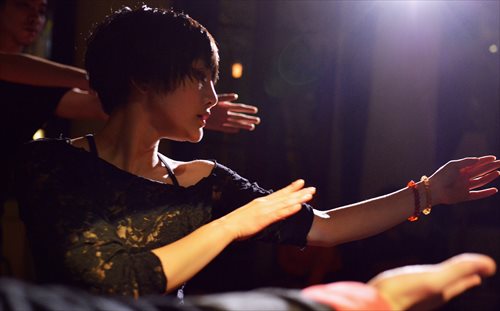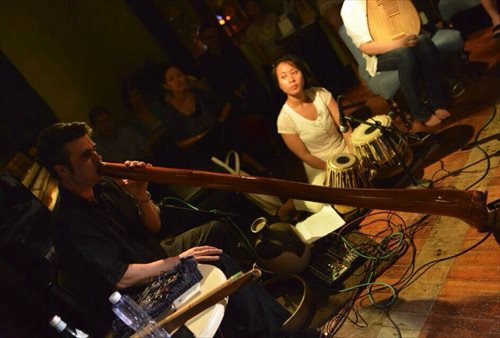Portraits in sound
New art form combines sign language and improvisation
In the eyes of conductor Jason Lasky and his team members, sounds can be "painted" with a series of body gestures. This genre-defying art form, called "soundpainting", is being introduced to Shanghai by a group of international artists to mark the 40th anniversary of its inception.
Soundpainting is a sign language for live composition, created by New York composer Walter Thompson in 1974. Presently, it comprises more than 1,200 gestures signed by the conductor, who is referred to as the soundpainter.

Physical performance artist Vivienne He dances to the sign language. Photo: Courtesy of the artist

Performers play instruments during the show. Photo: Courtesy of Jason Lasky
During the performance, the conductor uses the sign language to continuously indicate the sounds and movements he desires from the performers, who include musicians and dancers. Through the signs, he develops the performers' responses in real time, and molds them into a composition. Each soundpainting performance is completely improvised and unique.
Standing in front of a group of musicians and dancers, Lasky makes a set of different gestures. These might include making a V-gesture with two fingers, which he then moves along his forearm; or holding his hands high over his head with his fingertips touching. Whatever movements he does, the performers can immediately understand and render them into notes or dance steps. Instruments in the ensemble include piano, pipa (a two-stringed bowed musical instrument), percussion and didgeridoo.
"Whatever one artist gives to another must be taken in and accepted and then either reciprocated or repackaged. It's always a give-and-take scenario," Lasky said. "Of all the live art performances I've witnessed or been a part of, soundpainting allows for the freest expression, since it has the ability to evolve in real time.
"It is founded on the principle of listening and responding to improvised creations coming from several different sources. It is, at its core, a more organic art," Lasky added.
During one show, there was a moment in which one of the musicians began to breathe loudly in response to what another musician was doing. Finding that to be an interesting choice, Lasky gave a gesture to the rest of the group to synchronize with it. The breathing patterns evolved with the addition of small sounds and variations, and soon everyone onstage was breathing and making strange vocalizations which, as Lasky perceived, changed the vibe of the room. "Allowing for something like that to happen was one of those unexpected joys," he added.
The artists' unconventional methods of using the instruments also add to the originality of the approach. "Rather than beat the drums, an artist may stroke the drum surface lightly to render very unique sounds that we seldom hear," Wang Zheng, a member of the orchestra, said.
Improvising a group performance can sometimes be chaotic, and runs the risk of derailing. "It's a risk every time, but that's the joy of soundpainting. I'm actually an advocate of chaos, especially with media like this. Sometimes I even try to bring chaos intentionally," said Lasky.
According to Renaud Gay, a member of the orchestra from France, chaos is not necessarily a bad thing as it also incubates innovation and creation. "Chaos is to order what sound to silence. It's a dialectical unity," he said.
The ensemble was started when Lasky introduced the art form to physical performance artist Vivienne He, who had just established her own team called "Infinite Art", focusing on creating experimental contemporary artworks.
"When Jason introduced the art form to me, I thought it was an interesting project that aligned with our focus, so we decided to work with Jason to bring this new form to Shanghai," He said.
According to He, it took much practice for the team of artists from different disciplines to build communication through gesture. "We have to keep practicing and rehearsing to discover the range of each instrument's expressive capacity and responses to other artists' instruments, to build a tacit mutual understanding of each other's style and to explore the infinite possibilities of the textures and colors that we can create together," she said.
Dai Lan, a team member who has played the pipa for over 20 years, said that soundpainting has allowed her to break through musical boundaries and embrace a more diversified method of performance after spending so long immersed in classical Chinese music. "At first, we felt uncomfortable changing some of our fixed concepts, but now it's quite a natural and easy thing to deal with. We develop our music freely with no rigid rules or forms, except for our true feelings and emotions," she said.
These introductory performances are the first steps in the group's project to bring soundpainting to China.
"We have been preparing for the last few months and cannot wait to share what we have been creating," Lasky said. "We are hoping to expand the ensemble and build the art form in China. As soundpainting groups exist all around the world, we hope to build as many international bridges as possible."
The show will be given at Chartres Dimanche (246 Fuxing Road West) from 7:30 pm to 9 pm Thursday and Friday for 100 yuan ($16.18) per person at the door. A 10 percent discount is available on tickets bought from Chartres Dimanche before the show dates. Call 157-2153-4465 for details.